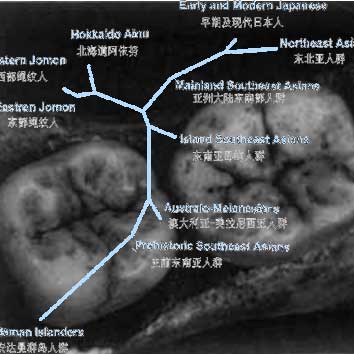 COM.on C.A.4:e12/78-82
Online published on Jun.23, 2010.
COM.on C.A.4:e12/78-82
Online published on Jun.23, 2010.doi:10.4236/coca.2010.41012
 COM.on C.A.4:e12/78-82
Online published on Jun.23, 2010.
COM.on C.A.4:e12/78-82
Online published on Jun.23, 2010.ZHOU Weichen, TAN Jingze
MOE Key Laboratory of Contemporary Anthropology, School of Life Sciences, Fudan University, Shanghai 200433 China
Key words: Dental anthropology; Dental non-metrical traits; the origin of the Japanese; Jomon people
Recieved: Jun.9, 2010 Accepted: Jun.22, 2010 Corresponding: tanjingze@gmail.com
《现代人类学通讯》第四卷e12篇 第78-82页 2010年6月23日网上发行
热点争议
牙齿人类学分析提示日本绳纹人的东南亚起源
周玮晨,谭婧泽
复旦大学现代人类学教育部重点实验室,上海 200433
摘要:日本古代绳纹人主要生活在距今1.2万到2.3千年前的日本列岛地区,是一类新石器时代狩猎-采集人群。绳纹人的起源在人类学中一直悬而未决。本文通过搜集牙齿人类学资料,比较了绳纹人与亚洲不同时间、地区人群的牙齿性状特征,结果提示绳纹人可能从东南亚地区起源。
关键词:牙齿人类学;牙齿非测量特征;日本人群起源;绳纹人
参考文献 References
1.
刘武(1996)牙齿人类学进展评价. 人类学学报
15(1):89-91.
2. Wolpoff MH (1971) Metric trends
in hominid dental eeolution.
Cleveland: The Press of Case Western
Reserve University, 1997. 1-244.
3. Turner CG Ⅱ (1989)
Teeth and
prehistory in Asia. Sci Am
206(2):88-96.
4. Turner CG II (1990)
Major
features of Sundadonty and Sinodonty,
including suggestions about East
Asian microevolution, population
history, and late Pleistocene
relationship with Australian
Aboriginals. Am J Phys Anthropol
82:295-317.
5. Turner CG II, Nichol CR, Scott GR
(1991) Scoring procedures for key
morphological traits of the
permanent dentition: the Arizona
State University dental anthropology
system. Advances in dental
anthropology. New York: Wiley-Liss,
13-32.
6. Nakahashi T (2005) Origin of
Japanese. [Nihonjin no Kigen.]
Koudansha, Tokyo (in Japanese).
7. 周蜜(2007)日本人种论. 吉林大学博士毕业论文.
8. Hanihara K (1991) Dual structure
model for the population history of
the Japanese. Japan Rev 2: 1-33.
9. Dodo Y (1987)
Supraorbital
foramen and hypoglossal canal
bridging;The two most Suggestive
nonmetric canial traits in
discriminating major racial grouping
of man. J Anthrop Soc Nippon
95:19-35.
10.
谭婧泽(2002)中国古代人骨眶上孔和舌下神经管二分发生率的调查与日本人起源问题的讨论.
人类学学报 15(2):21.
11. 尚虹,韩康信,王守功(2002)山东鲁中南地区周-汉代人骨研究.
人类学学报 15(1):9-10.
12.
王令红(1987)中国人和日本人在人种上的关系--颅骨测量性状的统计分析研究.
人类学学报 4(1):10-15.
13. Dodo Y, Ishida H (1990)
Population history of Japan as
viewed from cranial nonmetric
variation. J Anthrop Soc Nippon, 98:
269-287.
14.
筱田谦一,张全超(2002)通过线粒体DNA序列分析古代日本社会.
北方文物 15(3):108-112.
15. omohito N, Kazuaki H (2006)
Tooth size of the medieval period
people of Japan. Anthropol Sci
114:117-126.
16. Kondo M, Matsu'ura S (2005)
Dating of the hamakita human remains
from Japan. Anthropol Sci
113: 15-161.
17. Yoneda M, Saso A, Suzuki R,
Shibata Y, Morita M, Suwa G, Akazawa
T (2005)
Chronology of the Yayoi
skeletal remains from the Kanto
district: a preliminary
re-evaluation by radiocarbon dating
of postcranial material. Anthropol
Sci 113: 169-182.
18. Howells WW (1966) The Jomon
population of Japan: a study by
discriminant analysis of Japanese
and Ainu crania. Pape Peabody Mus
Archaeol Ethnol, 57: 1-43.
19. Turner CG II (1976)
Dental
evidence on the origin of the Ainu
and Japanese. Science 193: 911-913.
20. Pietrusewsky M (2004)
Multivariate comparisons of female
cranial series from the Ryukyu
Islands and Japan. Anthropol Sci
112: 199-211.
21. Ossenberg NS, Dodo Y, Maeda T,
Kawakubo Y (2006)
Ethnogenesis and
craniofacial change in Japan from
the perspective of nonmetric traits.
Anthropol Sci 114: 99-115.
22. Matsumura H (2000)
Dental metric
variation s between the periods,
sites and individuals of the
Neolithic Jomon people in the
Setouchi, Tokai and Kanto regions. M
Nat Sci Mus, 32: 175-187.
23. Matsumura H (2000)
Comparative
study of the crown cusp areas in the
maxillary second molars of the Jomon
people. B Nat Sc Mus, D26: 31-38.
24. Matsumura H (2007)
Non-metric
dental trait variation among local
sites and regional groups of the
Neolithic Jomon period, Japan. Anthropol Sci 115: 25-33.
25.
刘武,杨茂有(1999)中国古人类牙齿尺寸演化特点及东亚直立人的系统地位.
人类学学报 18(3):176-192.
26. Berry AC, Berry RJ (1967)
Epigenetic variation in the human
cranium. J Anat101: 361-379.
27. Turner CG II (2005)
Dental
Anthropological Indications of
Agriculture Among the Jomon People
of Central Japan. Am J Phys Anthropol 51:619 - 635.
28. 张雅军 (2008)
日本人群的种族起源和演化. 日本史研究.
29. Horai S, Kondo R, Murayama K,
Hayashi S, Koike H, Nakai N (1991)
Phylogenetic affiliation of ancient
and contemporary humans inferred
from mitochondorial DNA. Philos T R
Soc 333:409-417.
30. Omoto K (1995) Genetic diversity
and the origins of the “Mongoloids”.
The Origin and Past of Modern Humans
as Viewed from DNA, World
Scientific, Singapore, pp. 92-109.
31. Omoto K, Saitou N (1997)
Genetic
origins of the Japanese: a partial
support for the “dual structure
hypothesis”. Am J Phys Anthropol
102: 437-446.
32. Oota H, Saitou N, Matsushita T,
Ueda S (1999)
Molecular genetic
analysis of remains of a
2,000-year-old human population in
China- and its relevance for the
origin of the modern Japanese
population. Am J Hum Genet 64:
250-258.
33. Shigematsu M, Ishida H, Goto M,
Hanihara T (2004)
Morphological
affinities between Jomon and Ainu:
reassessment based on nonmetric
cranial traits. Anthropol Sci 112:
61-72.
34. Yamaguchi B (1992)
Skeletal
morphology of the Jomon people.
Japanese as a Member of the Asian
and Pacific Populations.
International Research Center for
Japanese Studies, Kyoto, pp. 53-63.